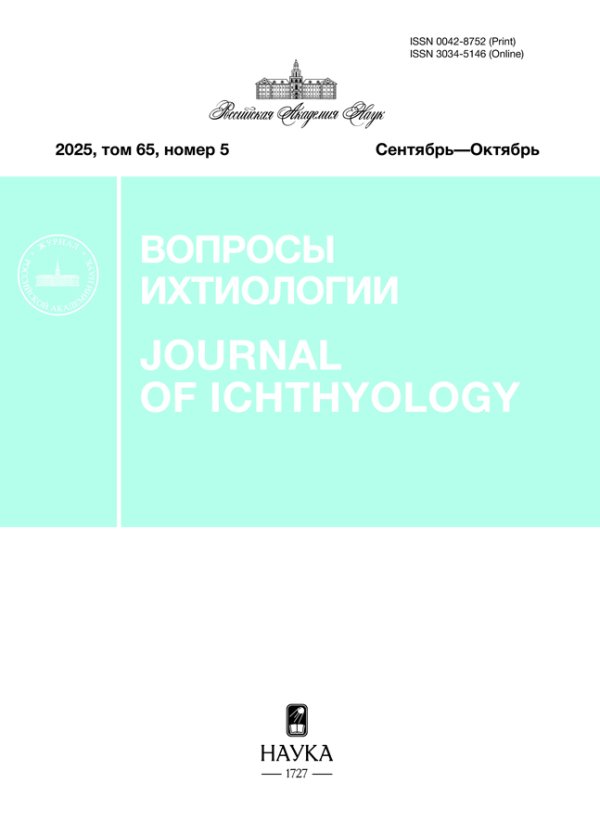Journal of Ichthyology
ISSN (Print): 0042-8752
Media registration certificate: ПИ № ФС 77 - 80520 от 23.03.2021
Founders
- Russian Academy of Sciences
- Severtsov Institute of Ecology and Evolution of RAS
Editor-in-Chief
- Pavlov Dmitrij Sergeevich, academician RAS, Doctor of Sc., Full Professor
Frequency / Access
6 issues per year / Subscription
Included in
White list (3rd level), Higher Attestation Commission list, RISC
Current Issue
Vol 65, No 5 (2025)
Articles
MORPHOLOGICAL AND GENETIC DIVERSITY OF THE PIDSCHIAN-LIKE WHITEFISH COREGONUS LAVARETUS (SALMONIDAE) IN THE WATER BODIES OF SIBERIA, RUSSIA
Abstract
 511-530
511-530


NEW DATA ON THE MORPHOLOGY OF MYOXOCEPHALUS SCORPIOIDES (COTTIDAE) FROM THE CHAUN BAY OF THE EAST SIBERIAN SEA AND ANALYSIS OF THE VARIABILITY OF SOME DIAGNOSTIC CHARACTERS OF THE SPECIES
Abstract
 531-541
531-541


GENETIC VARIABILITY AND RELATIONSHIPS OF THE THREADED SCULPIN GYMNOCANTHUS PISTILLIGER (COTTIDAE)
Abstract
 542–556
542–556


ZOOGEOGRAPHICAL ZONING OF NORTHERN EUROPEAN RUSSIA BY THE COMPOSITION OF FRESHWATER ICHTHYOFAUNA
Abstract
 557-575
557-575


DISTRIBUTION AND SOME ASPECTS OF BIOLOGY OF LYCODES CF. BRASHNIKOVI (ZOARCIDAE) WITH NOTES ON THE SPECIES COMPOSITION OF GENUS LYCODES OFF THE PACIFIC COAST OF KAMCHATKA
Abstract
 576-589
576-589


BIOLOGICAL PARAMETERS OF TRACHURUS MEDITERRANEUS (CARANGIDAE) OFF THE COAST NEAR SOUTHWESTERN CRIMEA DURING THE PERIOD FROM 2020 TO 2022
Abstract
 590–604
590–604


DURATION OF EMBRYONIC AND LARVAL DEVELOPMENT OF CHUM SALMON ONCORHYNCHUS KETA (SALMONIDAE) ON SAKHALIN AND ITURUP ISLANDS
Abstract
 605–617
605–617


INFLUENCE OF TEMPERATURE ON SPONTANEOUS LOCOMOTOR ACTIVITY OF THE SADDLER BICHIR POLYPTERUS ENDLICHERII (POLYPTERIDAE)
Abstract
 618-624
618-624


HISTOLOGICAL STRUCTURE OF LIVER, TRUNK KIDNEY AND SPLEEN OF THE ALTAI OSMAN OREOLEUCISCUS POTANINI (CYPRINIDAE) FROM THE ISOLATED POPULATION OF LAKE KIDELYU (ALTAI REPUBLIC, RUSSIA)
Abstract
 625–639
625–639


КРАТКИЕ СООБЩЕНИЯ
FINDING OF THE PEACOCK BLENNY SALARIA PAVO (BLENNIDAE) IN THE KERCH STRAIT (CRIMEAN PENINSULA) AND SOME OF ITS ECOLOGICAL AND BEHAVIORAL FEATURES
Abstract
 640–644
640–644












